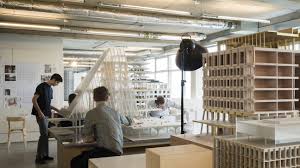Exploring the Beauty of Studio Architecture: Innovative Designs for Modern Living

The Art of Studio Architecture
Studio architecture is a unique and innovative approach to designing spaces that blend functionality with creativity. Studios are known for their versatility, adaptability, and ability to maximize space efficiently while maintaining aesthetic appeal.
One of the key features of studio architecture is its open-concept design, which allows for seamless flow between different areas within a space. This design philosophy creates a sense of spaciousness and freedom, making studios ideal for various purposes such as living spaces, workspaces, art studios, and more.
Studio architects focus on maximizing natural light and ventilation to create bright and airy environments that promote productivity and well-being. They often incorporate large windows, skylights, and glass walls to blur the boundaries between indoor and outdoor spaces.
In addition to their emphasis on natural elements, studio architects also pay close attention to detail when it comes to materials and finishes. They often use sustainable materials such as reclaimed wood, bamboo flooring, energy-efficient fixtures, and low-VOC paints to create eco-friendly spaces that are both beautiful and environmentally conscious.
Collaboration is another hallmark of studio architecture. Architects work closely with clients to understand their needs, preferences, and lifestyle in order to create personalized designs that reflect their vision. This collaborative process ensures that the final result is not only aesthetically pleasing but also functional and tailored to the client’s specific requirements.
Whether you’re looking to transform your living space into a modern studio apartment or design a dynamic workspace that fosters creativity and collaboration, studio architecture offers endless possibilities for creating unique and inspiring environments that enhance quality of life.
5 Essential Tips for Designing an Efficient and Comfortable Studio Space
- Ensure proper lighting design to create a conducive work environment.
- Incorporate flexible and multifunctional furniture to optimize space usage.
- Utilize soundproofing materials to minimize noise disruptions during recordings.
- Integrate technology for audio-visual equipment and connectivity needs.
- Prioritize ventilation and air circulation for a comfortable studio atmosphere.
Ensure proper lighting design to create a conducive work environment.
Proper lighting design is essential in studio architecture to cultivate a conducive work environment. By strategically incorporating natural light sources, such as large windows and skylights, and complementing them with artificial lighting fixtures, architects can create a well-lit space that enhances productivity and comfort. Adequate lighting not only illuminates work areas effectively but also contributes to the overall ambiance of the studio, promoting focus and creativity among occupants. Thoughtful consideration of lighting design is crucial in optimizing the functionality and aesthetic appeal of studio spaces, ensuring that they are both visually appealing and practical for work activities.
Incorporate flexible and multifunctional furniture to optimize space usage.
In studio architecture, a valuable tip is to incorporate flexible and multifunctional furniture to optimize space usage effectively. By choosing furniture pieces that can serve multiple purposes, such as a sofa bed or a dining table that can be folded away when not in use, you can maximize the functionality of your space without compromising on style. This approach not only helps in creating a versatile environment but also allows for easy adaptation to different activities and needs within the studio, making it a practical and efficient design solution for optimizing space usage.
Utilize soundproofing materials to minimize noise disruptions during recordings.
When incorporating soundproofing materials in studio architecture, it is crucial to prioritize minimizing noise disruptions during recordings. By strategically utilizing soundproofing materials such as acoustic panels, double-glazed windows, and sound-absorbing insulation, architects can create a conducive environment for capturing high-quality audio without interference from external noise sources. This attention to detail in soundproofing not only enhances the overall recording experience but also ensures that the studio space maintains a quiet and focused atmosphere essential for producing professional-grade audio recordings.
Integrate technology for audio-visual equipment and connectivity needs.
Integrating technology for audio-visual equipment and connectivity needs is a crucial tip in studio architecture to enhance the functionality and versatility of the space. By incorporating state-of-the-art audio-visual systems, smart lighting controls, and seamless connectivity solutions, studio architects can create a modern environment that caters to the demands of today’s digital age. This integration not only improves the overall user experience but also allows for greater flexibility in how the space can be utilized for various purposes, such as presentations, meetings, entertainment, or creative projects. Embracing technology in studio architecture ensures that the space remains adaptable and future-proof while providing a seamless and immersive experience for its users.
Prioritize ventilation and air circulation for a comfortable studio atmosphere.
When designing a studio space, prioritizing ventilation and air circulation is essential to creating a comfortable and inviting atmosphere. Adequate airflow not only helps regulate temperature but also improves indoor air quality, promoting a healthier environment for occupants. Incorporating features such as large windows, skylights, and strategically placed vents can enhance natural ventilation and bring fresh air into the space. Proper air circulation helps prevent stuffiness and allows for better concentration and productivity in the studio, making it a more enjoyable and conducive place to work or relax.
